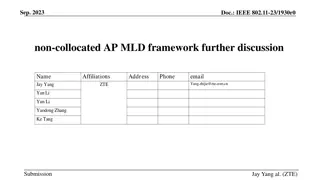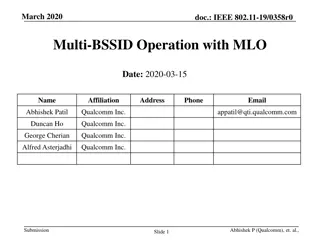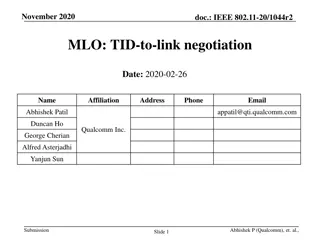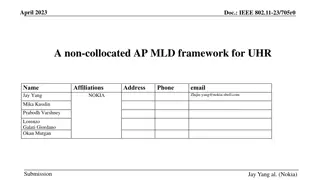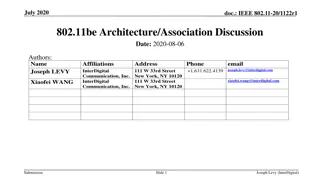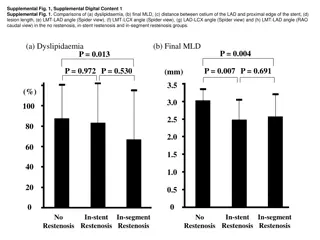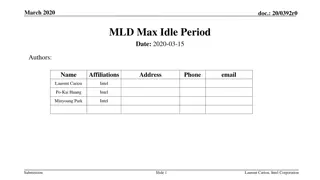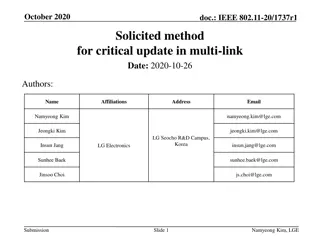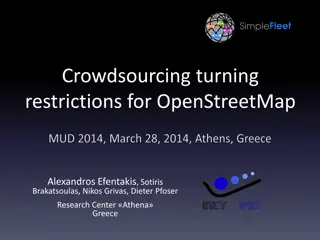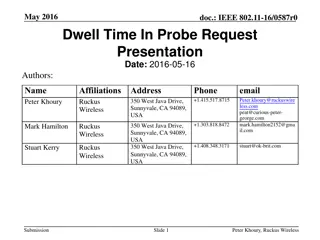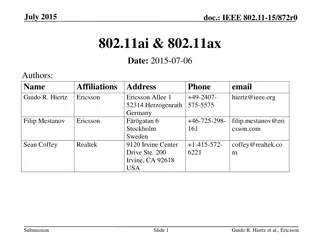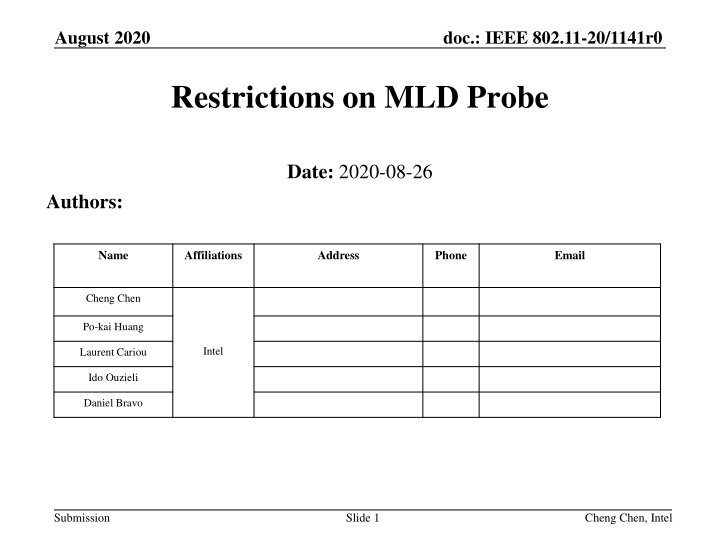
MLD Probe Requests in IEEE 802.11-20
Explore the concept of MLD probe requests in IEEE 802.11-20 standard for multi-link discovery, including the differentiation between regular probe requests/responses and MLD probe requests/responses. Learn about the restrictions and benefits associated with MLD probe requests for efficient network setup and management.
Download Presentation

Please find below an Image/Link to download the presentation.
The content on the website is provided AS IS for your information and personal use only. It may not be sold, licensed, or shared on other websites without obtaining consent from the author. If you encounter any issues during the download, it is possible that the publisher has removed the file from their server.
You are allowed to download the files provided on this website for personal or commercial use, subject to the condition that they are used lawfully. All files are the property of their respective owners.
The content on the website is provided AS IS for your information and personal use only. It may not be sold, licensed, or shared on other websites without obtaining consent from the author.
E N D
Presentation Transcript
doc.: IEEE 802.11-20/1141r0 August 2020 Restrictions on MLD Probe Date: 2020-08-26 Authors: Name Affiliations Address Phone Email Cheng Chen Po-kai Huang Intel Laurent Cariou Ido Ouzieli Daniel Bravo Submission Slide 1 Cheng Chen, Intel
doc.: IEEE 802.11-20/1141r0 August 2020 Background We already agreed that for Multi-link discovery Basic information of the MLD is carried in RNR in Beacon and probe response [Motion 115, #SP93] All APs that are part of the same MLD as a reporting AP and that are collocated with the reporting AP shall be reported in the RNR element that is included in the beacons and the broadcast probe responses transmitted by the reporting AP when the reporting AP is either not part of a multiple BSSID set or corresponds to a transmitted BSSID in a multiple BSSID set. Complete information of the MLD can be provided via a ML Probe request [Motion 115, #SP97, Motion 119, #SP109] 802.11be agrees to define a mechanism for a STA of a non-AP MLD to send a probe request frame to an AP belonging to an AP MLD, which enables to request a probe response from the AP that includes the complete set of capabilities, parameters and operation elements of other APs affiliated to the same MLD as the AP Note: Such a directed probe request requesting complete MLO information for one or more APs of the MLD is referred to as an ML probe request. Note: A probe response sent in response to an ML probe request containing complete MLO Information for the requested AP(s) is referred to as an ML probe response. Submission Slide 2 Cheng Chen, Intel
doc.: IEEE 802.11-20/1141r0 August 2020 Regular probe request vs. ML probe request We differentiate between regular probe request/response and MLD probe request/response: Regular probe request/probe responses: Probe request that contains mainly information on the link on which it is transmitted, and generates a regular probe response that contains the RNR (min information basic discovery) MLD probe request/probe responses: Probe request that requests complete MLD info on multiple links that the STA supports Probe response contains complete information on AP MLD These 2 probes are used differently by the STA: For basic initial discovery---use regular probe For collecting complete info before Multi-link setup---use MLD Probe Submission Slide 3 Cheng Chen, Intel
doc.: IEEE 802.11-20/1141r0 August 2020 Restrictions on ML probe request Since ML probe request/response includes complete information of all links supported by the MLD, the associated overhead is likely to be much larger than regular probe request/response. If we allow a non-AP MLD to arbitrarily use ML probe request, it may cause congestion in the links. In 6 GHz, we placed several restrictions on the use of probe request. In this contribution we propose to apply similar ideas to limit the use of ML probe request. Submission Slide 4 Cheng Chen, Intel
doc.: IEEE 802.11-20/1141r0 August 2020 Blind ML probe We prohibit blind probe request in 6 GHz in 11ax. 11ax 6 GHz: The non-AP STA shall not transmit a Probe Request frame to the broadcast destination address with the Address 3 field set to the wildcard BSSID, and the SSID set to the wildcard SSID. For MLD Probing, it should be done after basic discovery. Therefore, we should also prohibit blind MLD Probe Request. Proposed rule in 11be: A non-AP STA affiliated with a non-AP MLD shall not transmit a MLD Probe Request to the broadcast destination address with the Address 3 field set to the wildcard BSSID, and the SSID set to the wildcard SSID (Note : 6 GHz is already covered). This is consistent with the definition of an ML Probe request: Such a directed probe request requesting complete MLO information for one or more APs of the MLD is referred to as an ML probe request Submission Slide 5 Cheng Chen, Intel
doc.: IEEE 802.11-20/1141r0 August 2020 Frequency of ML probe We should also limit the frequency of transmitting MLD Probe Request, like what we did in 11ax in terms of limiting Probe Request in 6 GHz. 11ax 6 GHz: The non-AP STA shall not transmit more than one Probe Request frame to the broadcast destination address with the Address 3 field set to the wildcard BSSID and the SSID field not set to the wildcard SSID during each 20 TU period scanning the channel. The non-AP STA shall not transmit more than three Probe Request frames to the broadcast destination address with Address 3 field set to a non-wildcard BSSID during each 20 TU period scanning the channel. Proposed rule in 11be: A non-AP STA affiliated with a non-AP MLD shall not transmit more than one MLD Probe Request frame to the broadcast destination address with the Address 3 field set to the wildcard BSSID and the SSID field not set to the wildcard SSID during each 20 TU period scanning the channel. A non-AP STA affiliated with a non-AP MLD shall not transmit more than three MLD Probe Requests to the broadcast destination address with Address 3 field set to a non- wildcard BSSID during each 20 TU period scanning the channel. Submission Slide 6 Cheng Chen, Intel
doc.: IEEE 802.11-20/1141r0 August 2020 Additional rules on ML probe In 11ax 6 GHz, we prohibit the non-AP STA to send a probe if it has already obtained the information from the AP. 11ax 6GHz: The non-AP STA shall not send a Probe Request frame to the broadcast destination address with the Address 3 field (BSSID) set to the BSSID of an AP from which it has already received a Probe Response or a Beacon frame since the start of its scanning on that channel. We should apply similar rules in 11be, prohibiting the use of MLD Probe Request if the non-AP MLD has already received complete information from the AP MLD. Proposed rule in 11be: None of the non-AP STAs of a non-AP MLD shall send an ML Probe Request frame to the broadcast destination address with the Address 3 field (BSSID) set to the BSSID of the AP of the AP MLD in the corresponding link if any non-AP STA of the same non-AP MLD has already received a ML Probe Response or a Beacon frame including complete information from any of the AP of the AP MLD in any link, since the MLME- SCAN.request primitive with ScanType parameter indicating an Active scan was issued. Note: complete information means information of all APs of the AP MLD Submission Slide 7 Cheng Chen, Intel
doc.: IEEE 802.11-20/1141r0 August 2020 Unsolicited Probe Response In 11ax 6 GHz, we defined unsolicited probe response. If implemented, the AP operating in 6 GHz schedules for transmission unsolicited probe response frames every 20 TUs or less. Considering the large overhead associated with ML probe response, we think ML probe response should only be sent when requested. In other words, such unsolicited probe response shall not be ML probe response. As a result, we propose the following: Proposed rule in 11be : Unsolicited probe responses sent by an AP with dot11UnsolicitedProbeResponseOptionActivated set to true shall not be ML probe response. Submission Slide 8 Cheng Chen, Intel
doc.: IEEE 802.11-20/1141r0 August 2020 Conclusions We proposed several rules to restrict the use of MLD Probe in 11be. To prevent probe storm . Most of the rules are adapted from the restriction rules in 11ax 6 GHz and extended to MLD Probe with similar ideas. Submission Slide 9 Cheng Chen, Intel
doc.: IEEE 802.11-20/1141r0 August 2020 SP 1 Do you agree with the following: A non-AP STA affiliated with a non-AP MLD shall not transmit an ML Probe Request to the broadcast destination address with the Address 3 field set to the wildcard BSSID, and the SSID set to the wildcard SSID Note: 6 GHz is already covered by existing rules in 11ax. Submission Slide 10 Cheng Chen, Intel
doc.: IEEE 802.11-20/1141r0 August 2020 SP 2 Do you agree with the following: A non-AP STA affiliated with a non-AP MLD shall not transmit more than one ML Probe Request to the broadcast destination address with the Address 3 field set to the wildcard BSSID and the SSID field not set to the wildcard SSID during each 20 TU period scanning the channel. A non-AP STA affiliated with a non-AP MLD shall not transmit more than three ML Probe Requests to the broadcast destination address with Address 3 field set to a non- wildcard BSSID during each 20 TU period scanning the channel. Submission Slide 11 Cheng Chen, Intel
doc.: IEEE 802.11-20/1141r0 August 2020 SP 3 Do you agree with the following: None of the non-AP STAs of a non-AP MLD shall send an ML Probe Request frame to the broadcast destination address with the Address 3 field (BSSID) set to the BSSID of the AP of the AP MLD in the corresponding link if any non-AP STA of the same non-AP MLD has already received a ML Probe Response or a Beacon frame including complete information from any of the AP of the AP MLD in any link, since the MLME-SCAN.request primitive with ScanType parameter indicating an Active scan was issued. Note: complete information means information of all APs of the AP MLD. Submission Slide 12 Cheng Chen, Intel
doc.: IEEE 802.11-20/1141r0 August 2020 SP 4 Do you agree with the following: Unsolicited probe responses sent by an AP with dot11UnsolicitedProbeResponseOptionActivated set to true shall not be ML probe response. Submission Slide 13 Cheng Chen, Intel

